The Skylake Core i3 (51W) CPU Review: i3-6320, i3-6300 and i3-6100 Tested
by Ian Cutress on August 8, 2016 9:00 AM ESTOffice Performance
All of our benchmark results can also be found in our benchmark engine, Bench.
Agisoft Photoscan – 2D to 3D Image Manipulation: link
Agisoft Photoscan creates 3D models from 2D images, a process which is very computationally expensive. The algorithm is split into four distinct phases, and different phases of the model reconstruction require either fast memory, fast IPC, more cores, or even OpenCL compute devices to hand. Agisoft supplied us with a special version of the software to script the process, where we take 50 images of a stately home and convert it into a medium quality model. This benchmark typically takes around 15-20 minutes on a high end PC on the CPU alone, with GPUs reducing the time.
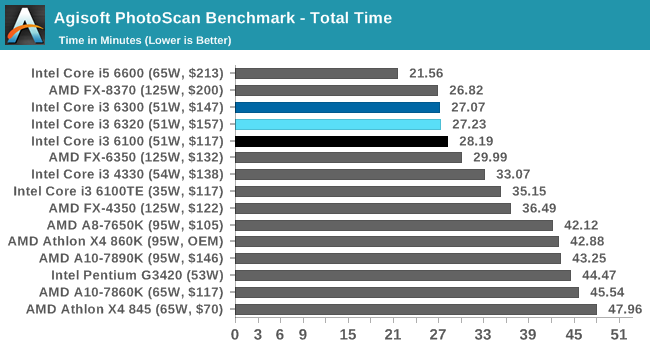
The different stages of Photoscan have different preferences for frequency and threads, but all the results are in Bench. In this case having threads matters, with the old 8-thread FX CPU barely getting ahead of the Core i3 parts. The i5 takes the lead, showing that having physical cores helps with cache management. This is further reinforced by our results staircase, which put the i3-6320 and i3-6300 at roughly equal timings but the i3-6100 almost 4% behind.
Cinebench R15
Cinebench is a benchmark based around Cinema 4D, and is fairly well known among enthusiasts for stressing the CPU for a provided workload. Results are given as a score, where higher is better.
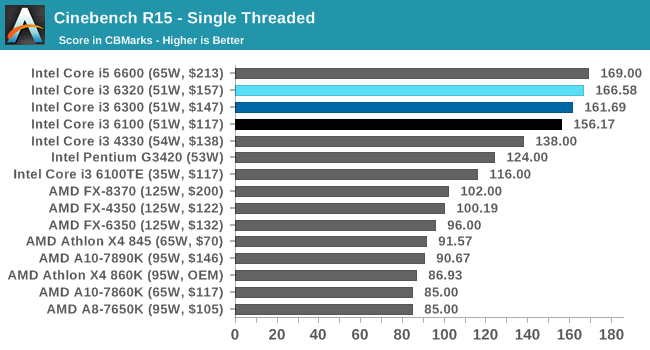
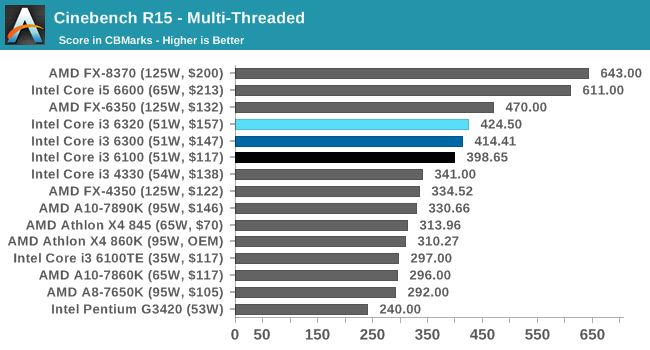
Cinebench eats threads, high IPC and high frequency for breakfast. In the single thread test, the high Intel IPC shines through, and our i3 parts sit in unison with AMD behind by up to 40%. In multithreaded land, the 6/8 thread FX processors go ahead of the i3s as expected, and our staircase slightly deviates for the i3-6100 showing that L3 cache creep is slowly coming in.
HandBrake v0.9.9: link
For HandBrake, we take two videos (a 2h20 640x266 DVD rip and a 10min double UHD 3840x4320 animation short) and convert them to x264 format in an MP4 container. Results are given in terms of the frames per second processed, and HandBrake uses as many threads as possible.
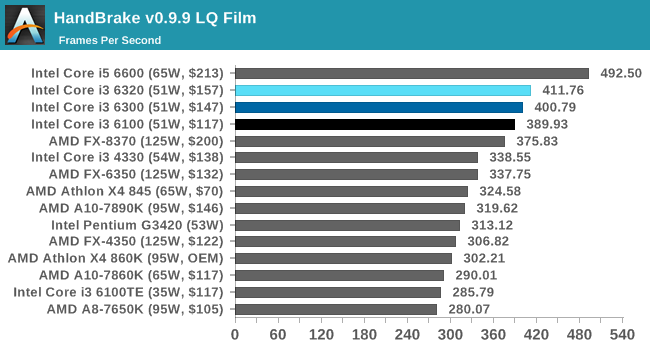
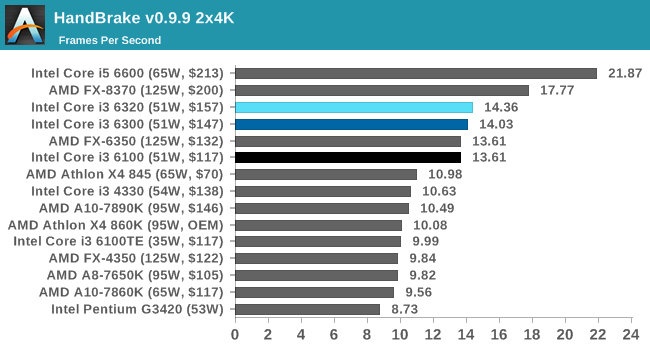
The high IPC of the Skylake parts makes a difference for the smaller frame conversion, while threads come into play for the larger resolution frames. In both cases, the regular staircase shows a lack of issues with the L3 cache differences, but it is interesting to see the X4 845 hot on the heels for the high resolution frames despite its cache arrangement. The FX-6350 sits on par with the i3-6100, showcasing the difference between a six-thread much older processor and a four thread latest process part.
Hybrid x265
Hybrid is a new benchmark, where we take a 4K 1500 frame video and convert it into an x265 format without audio. Results are given in frames per second.
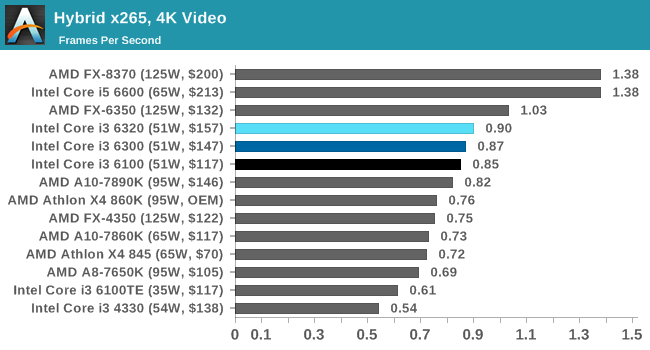
Hybrid is similar to HandBrake, and we again have a regular staircase.










94 Comments
View All Comments
jabber - Tuesday, August 9, 2016 - link
Yeah, unfortunately, a lot of IT guys assume that because they run quad cores at 100% all day long with 32GB of ram that Helen on the front desk or Mike in Sales needs the same. They don't. Similar to Ratman I sell a lot of recon Dell and HP ex corporate machines to my small business customers. 2010 spec machines with dual core 3GHz Pentiums with 4-8GB of ram. They can buy three of them for the cost of a 2016 model. They love them. If they need a real boost, a 120GB SSD gets slapped in. They pee their pants with excitement when that happens. Standard business computing was finally catered for many many years ago. It hasn't really changed.BrokenCrayons - Tuesday, August 9, 2016 - link
Decrepit Core 2 Duos are indeed perfectly acceptable for poking around on the internet and handling basic office workloads. I'm fairly happy using a T2310-based laptop (C2D@1.46GHz) with 2GB of RAM and a recently purchased 500GB 5400 RPM drive for most of my day-to-day computing tasks. I can feel the system's performance catching up when I ask the Intel x3100 graphics card to chug through anything higher than 720p video on Youtube. Most of my gaming is streamed through Steam so the box on the user end isn't as important as the computer that actually runs the game with reduces my concern pretty significantly when it comes to keeping my laptop up-to-date. I'm pretty sure I can squeeze another year or two out of it before handing it over to the electronics recycling center.Like jabber says, office work has long since been addressed by technological advancements and _most_ home computing needs aside from throwing around modern games have too.
Icehawk - Tuesday, August 9, 2016 - link
We have some C2Ds at work, and yeah for a regular office job they are fine IF they have 8gb of RAM, unfortunately these machines are so old keeping them running or upgrading is a hassle. And at least here, unless you are in IT or a programmer good luck getting a SSD. A newer i3 with 8gb and SSD is definitely enough for any casual user at work or home for sure.BrokenCrayons - Wednesday, August 10, 2016 - link
It depends a lot on the workload. 2GB is sufficient for almost everything I do on a home computer except for the occasional game. In an office setting 4-8GB would be better just because workforce users tend to leave a larger number of programs open at once. I do agree that in a workplace, computers should still be replaced every 3-5 years due to upgrade and maintenance issues that crop up as they age past that point even if the system performance is still perfectly adequate.lilmoe - Monday, August 8, 2016 - link
Do tell how to spread a select query (with a join or two) on multiple equally tasked threads when you only need to query a huge table (with the others being relatively tiny).i3s are my go-to recommendation for clients needing POS stations and others that only need a client/terminal for an ERP database.
lilmoe - Monday, August 8, 2016 - link
What's being multithreaded is the UI, almost exclusively. And that's for responsiveness rather than speed, in which 2 cores more than suffice.elbert - Monday, August 8, 2016 - link
Thats not how it works. This is like arguing against dual cores because there was no threaded software. Chicken and the egg is a fun game but the process has to come first.bug77 - Tuesday, August 9, 2016 - link
There's no chicken and egg here. We've had 8 thread capable CPUs for years. But we simply don't need them at home or for typical desktop usage.They're great for 3D rendering, video editing or programming, but they're not for everyone.
elbert - Tuesday, August 9, 2016 - link
Dual cores aren't for everyone so lets just agree they should moved to a tablet or watch. Intel needs to move on 6 core Kaby Lake for the main steam at the very least.bug77 - Wednesday, August 10, 2016 - link
No, we don't agree on that. Dual core is plenty for typical web browsing and occasionally writing a paper for school. I'm on an i5 for years and I rarely see all 4 cores put to use at the same time.You're entitled to your opinion, of course, but I don't agree with it.